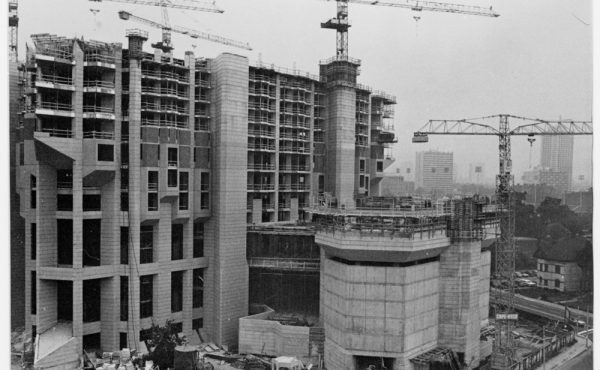
WHAT: Building on History
WHERE: Harbourfront Centre
WHEN: Jan 23 – June 14, 2009
OPENING: Tonight: Friday Fri Jan 23, 6-10PM
The map above is a panel from the 1858 Boulton Atlas of Toronto — one of the earliest maps of a Toronto that is still recognizable today. ERA Architectects have blown up the map to mural-size and highlighted the buildings that still stand today as part of Harbourfront’s “Building on History” show, a collection of four exhibits that look at how cities can continue to grow — to “build” — in the midst of its history.
Canada’s Goldsmith Borgal & Company Ltd. Architects, E.R.A. Architects Inc. and Taylor Hazell Architects Ltd. were invited to create installations in response to the of idea building on history.
The exhibition Building on History also features a selection of work from the photographic series Elegy for a Stolen Land by Peter Sibbald in response to his own reflections and questions posed by this idea.
The objective of this architecture gallery is to present exhibitions which will educate, challenge and question the thoughts and the ideas which inform contemporary architecture.
Information on each exhibit after the jump.
Found Toronto
E.R.A. Architects Inc.
 When we walk through the streets of Toronto it’s sometimes hard to know what’s old and what’s new. Is this a historic building, or is it new and just looks old? The city is constantly evolving and growing so it can be hard to tell what “Old Toronto” was like, and what parts still exist.
When we walk through the streets of Toronto it’s sometimes hard to know what’s old and what’s new. Is this a historic building, or is it new and just looks old? The city is constantly evolving and growing so it can be hard to tell what “Old Toronto” was like, and what parts still exist.
As we celebrate Toronto’s 175th birthday in 2009 we can look at the 1858 Boulton Atlas — one of the earliest city maps. Found Toronto recreates that map on a massive scale, letting you stand in front of the city that was and, if you use your imagination, take a walk down those early Victorian streets. Found Toronto lets us see how the old Toronto connects to contemporary Toronto, and shows us where our history may lie, both out of sight and in plain view.
Team: Adriana Balen, Andrew Choptiany, Andrew Pruss, Ben Huntley, Chris Lawless, Edwin Rowse, George Martin, Graeme Stewart, Jan Kubanek, Jeff Hayes, Jennifer Drinkwater, Jessie Grebenc, Joey Giaimo, Kerri Goudie, Kirsty Bruce, Lindsay Reid, Matt Blackett, Matthew Somerville, Michael McClelland, Philip Evans, Robyn Huether, Scott Weir, Sonya Tytor
Collaborators: Shawn Micallef, Stephen Otto
Material Collaborators: Astley Gilbert and special thanks to the Toronto Public Library
Take 2
Goldsmith Borgal & Company Ltd. Architects
 In our consumer driven society, reusing buildings is not only environmentally responsible, it is also culturally desirable. Architecture is the most enduring art form of mankind. If time and utility abandon it, creative transformations are required to re-animate, re-connect and re-weave these elements back into our urban and social fabric. Their beauty, history and cultural significance layer our cities with meaning and wonder.
In our consumer driven society, reusing buildings is not only environmentally responsible, it is also culturally desirable. Architecture is the most enduring art form of mankind. If time and utility abandon it, creative transformations are required to re-animate, re-connect and re-weave these elements back into our urban and social fabric. Their beauty, history and cultural significance layer our cities with meaning and wonder.
Reusing elements from the previous exhibit and drawing on both modern and historic references for our inspiration, this installation demonstrates the essential process of re-ordering our built environment and re-connecting with our past. Re-ordering is essential for the functionality of the space: the ‘fit’ of its new use. Re-connecting makes reference to the human experience, perception and understanding of our natural and manmade environments, and the intersection of the two.
In order to better inform and inspire others, we invite visitors to share their thoughts on their personal journey in time and space as facilitated by these exhibits.
Team: Christopher Borgal, Claudia Gu, Allan Killin, Gillian Haley
Material Collaborators: Donald Chong Studio, Clifford Masonry Limited, Midtown Reproduction Services
The Redemptorist Project: Studies in Risk, Conservation and Architectural Response.
Taylor Hazell Architects Ltd.
 Building is a defining activity for our species and we have done a lot of it. History is a specific form of documentation whose purpose is to convey cultural content and commentary on our human condition. Our times, that reach of living memory, have presided over the most appalling destruction of the built world where over 50 percent of mankind’s historical architectural heritage has been destroyed. Much of this has been with a form of violence and banal disregard that defies belief. The effect on the natural environment and ecosystem is, as we know, no less catastrophic. It would be delusional to regard our efforts as architects as independent of these forces. Indeed it is exactly how we respond to this condition and conservation in particular that will determine the nature and extent of our recovery.
Building is a defining activity for our species and we have done a lot of it. History is a specific form of documentation whose purpose is to convey cultural content and commentary on our human condition. Our times, that reach of living memory, have presided over the most appalling destruction of the built world where over 50 percent of mankind’s historical architectural heritage has been destroyed. Much of this has been with a form of violence and banal disregard that defies belief. The effect on the natural environment and ecosystem is, as we know, no less catastrophic. It would be delusional to regard our efforts as architects as independent of these forces. Indeed it is exactly how we respond to this condition and conservation in particular that will determine the nature and extent of our recovery.
Our exhibit examines these issues through the lens of a single project — an incomplete work done in joint venture with Montgomery Sisam Architects. It involves the design of a monastery on an existing site in downtown Toronto for the Redemptorists, a Catholic order that has occupied the site since 1850. The exhibit raises questions about the role of institutions as transformative forces in our city, its sustaining culture and architectural response.
Team and Collaborators: Taylor Hazell Architects, Montgomery Sisam Architects, Clifford Restoration Limited, Paisley Brick and Tile and special thanks to the Redemptorists of St. Patricks Church, Toronto.
Elegy for a Stolen Land
Peter Sibbald
 Ontario-based documentary photographer Peter Sibbald was invited to exhibit a selection from his photographic series Elegy for a Stolen Land as part of Building on History. Using Southern Ontario as a personal ancestral starting point, this selection shows evidence of the dramatic shifts throughout history of how humans have constituted the meaning of land.
Ontario-based documentary photographer Peter Sibbald was invited to exhibit a selection from his photographic series Elegy for a Stolen Land as part of Building on History. Using Southern Ontario as a personal ancestral starting point, this selection shows evidence of the dramatic shifts throughout history of how humans have constituted the meaning of land.
This component of the exhibition of architecture and building on history is presented by the Visual Arts at Harbourfront Centre as part of an ongoing interdisciplinary focus.




4 comments
It would be really great if you could purchase a poster-sized version of that first map. Is that in the works?
Will check tonight. I’d buy one. You’d buy one. How big is the rest of the market though?
We’ll have postcards at the opening this evening and the exhibition is accompanied with a brochure.
Limited number friends!
I’d buy a couple for myself and as gifts. Fabulous as the recent Historical Atlas of Toronto is, the maps are just too small to be really readable. One wonders why a digital second volume with actual size-possible versions couldn’t have been published. That too I’d buy.